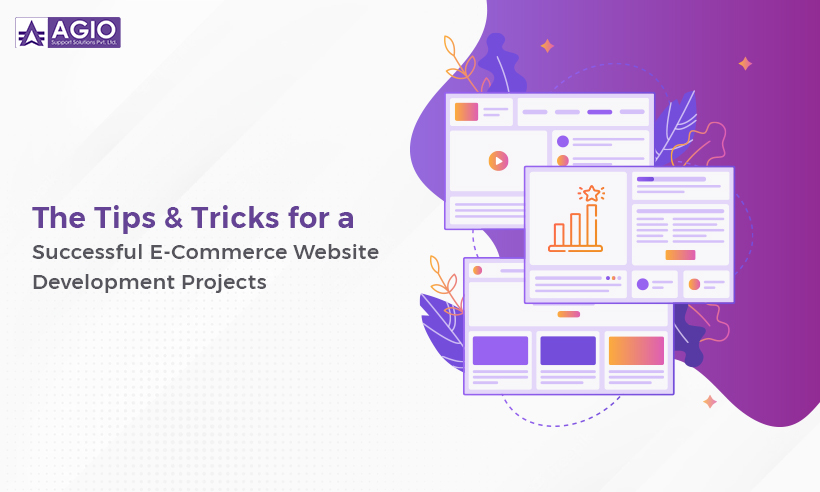The Tips & Tricks for a Successful E-Commerce Website Development Projects


E-Commerce Website Development
Your eCommerce website is equivalent to department stores in that first impressions count. Consumers will be drawn in by appealing visual merchandising, and well-organized products will motivate them to browse and buy. Cluttered and disorganized stores will affect customers from entering and will make less profit. An eCommerce website is distinct from other types of websites. Other considerations include SSL configuration, online payment, site architecture, design, load times speed, and visual art, to name a few. You’ll need a foundation that can handle enough server resources. Alternatively, your store may experience a severe downturn or even crash. Check out this resource to learn more about how hiring the best E-Commerce Website Development can deliver your company with a competitive edge.
Table of Contents
Why You Should Invest in E-Commerce Website Development?
Establishing the framework, website design, programming, publishing, and database management are all part of the eCommerce website development process.
If your site currently is no longer going to perform well, does not appear professional, or is not visually striking, it is time to redesign it.
Whether you’re thinking about building or renovating your eCommerce website, here are key points to bear in mind to achieve project success.
The Ecommerce Website Design Tips to Maximize Sales
All of these suggestions are simple enough to incorporate that they are well worth a shot. Try any or all of them and see how they work for your company. Examine it out.
Make it More Mobile-Friendly
A large number of consumers will be browsing through your site on their mobile devices. If your page is not mobile-responsive, you will instantly lose that number of consumers. As a result, our first piece of advice is to keep your shop mobile-friendly.
To make sure of this, a great web builder will automatically switch your website into smartphone templates. Because you’re completely online, this is incredibly beneficial for e-commerce platforms. You just want to have the same opportunity to shop with you.
Make Use of a Simple Website Design
Aesthetically compelling and trustable minimalist websites significantly beat compelling visual websites. If you ever want to improve the conversion rate of your e-commerce website, take into account restructuring it. To make the configuration of your e-commerce website easier.
Remove any extraneous information and use a minimalist design theme with plenty of white space. If you need assistance deciding on a website design platform, recognize using E-Commerce Website Development platforms such as: For expanding e-commerce businesses, consider WordPress, Shopify, WooCommerce, or BigCommerce.
Keep Everything Simple & Minimal
While it may be enticing to add a lot of interactive elements or visuals to a site, doing so can overpower your visitors and push them away. Simple is always better when it comes to e-commerce website design. Nobody desires to click through 5 pages, cope with a million popups, or look for the main navigation that doesn’t exist. Such design flaws result in lost clients, which corresponds to revenue loss.
Consider your design as if you were the ultimate user. Would you find it difficult to navigate your website? Can you discover everything you need in a couple of clicks? Are our menus and buttons labeled plainly and validly? All of these concepts should be considered when designing your store.
Other simple design principles involve:
- Easily scannable content
- Fonts that are simple and readable
- Consistent color schemes
- Navigation elements that are easily identified
- Product categories are easily accessible.
Ensure that the client your product, clearly describe it, and explain how they can purchase it.
Search Engine Optimization and Site Performance
PageRank remains important for traffic. Use appropriate eCommerce SEO and search marketing to ensure that your pages score better and that customers can discover you.
It’s worthwhile because the CTR falls by more than half from first to second place in the search engine results. Site performance and page load speed also have a significant impact on your UX and Google ranking. Overeager customers can easily abandon slow-loading websites. According to one study, 40% of shoppers abandon a website if it takes more than 3 seconds to load.
The bottom line is that quick loading pages end up with a better customer experience, which is beneficial to everyone.
Make Checkout Quick and Easy
It should go without saying, but it needs to be repeated: Do not make your clients work too hard when they arrive at your payment page. You put in a deal of time and resources to create a website that gets buyers to the finish line. Make certain they do not cross it.
Allow consumers to test out as visitors. Start making them completely out as few data fields as conceivable with only the data that is necessary. Label those data fields explicitly. Allow them to see a product preview with an explanation in their cart so they can double-check what they’re purchasing.
To obtain their product, the consumer must understand what information they must provide, why they must provide it, and how they will protect it. Then, make the process as simple as possible for them.
Make Use of Reviews and Testimonials
When researching a new product, one of the first things some people do is read feedback from customers. What did others think about the product? What was their overall impression of your company? This is the type of data you want people to see.
Include a rating scheme in your e-commerce website design and encourage people to send honest feedback. Obviously, try to get as many good aspects as possible. A slew of 4 and 5-star reviews can do a lot to boost someone’s faith and confidence. People can trust you are far more likely to purchase your product or service.
Another way to establish trust is to include an easily accessible FAQ page in your e-commerce website design. There, you can respond to your consumers’ most commonly asked questions. Include that in the top and bottom navigation menus, and link to it from other sections of the website as needed. Consider developing a forum where other knowledgeable clients can respond to questions.
Always Keep User in Mind
The most essential thing, at the end of the day, has always been to keep in mind the customer. Build the perfect buying experience possible so that customers will return. Building your shop around them is one of the swiftest ways of building customer loyalty and converting customers into repeat customers, life-long customers.
This could relate to how simple it is to buy, writing good product explanations, using a seamless interface, and being conscious of your color combination. You can get an honest opinion about what your clients like best by participating with them through questionnaires, social networking sites, or other forms of organization.
Buyers will start noticing how much effort was put into optimizing their experience. Leave a great impression by following the e-commerce web developer steps correctly.
Final Thoughts
E-commerce website design that is efficacious increases conversions and contributes to your overall online achievement. Even if you’re not the most professional artist, do not even have an in-house designer, or don’t have a lot of time to devote to your design, you can still accomplish a conversion-optimized web store design.
Including share buttons on your product pages, blog posts, and other pages are also one of the greatest things you can do for your E-Commerce Website Development site. Your shoppers can use share buttons to share the products they like with their friends, family, and followers. It’s like getting free publicity! You can also use our picture share buttons to enable consumers to obtain your best product photos with a link back to the product’s page on your website, allowing you to easily entice the audience and increase sales!








